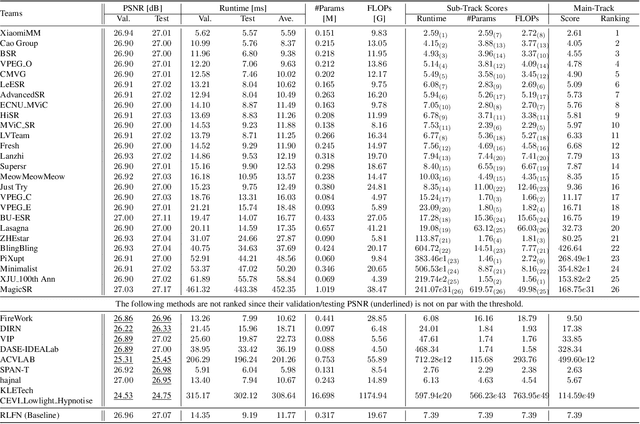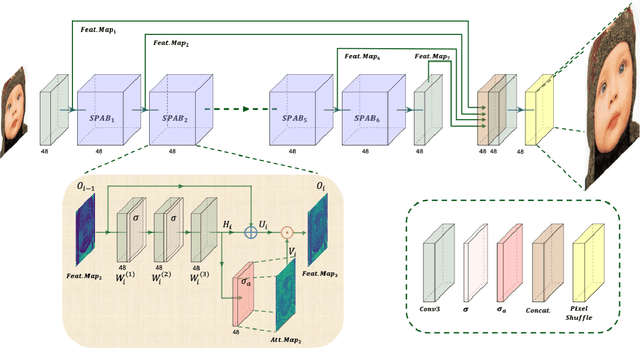Akram Khatami-Rizi
The Tenth NTIRE 2025 Efficient Super-Resolution Challenge Report
Apr 14, 2025Abstract:This paper presents a comprehensive review of the NTIRE 2025 Challenge on Single-Image Efficient Super-Resolution (ESR). The challenge aimed to advance the development of deep models that optimize key computational metrics, i.e., runtime, parameters, and FLOPs, while achieving a PSNR of at least 26.90 dB on the $\operatorname{DIV2K\_LSDIR\_valid}$ dataset and 26.99 dB on the $\operatorname{DIV2K\_LSDIR\_test}$ dataset. A robust participation saw \textbf{244} registered entrants, with \textbf{43} teams submitting valid entries. This report meticulously analyzes these methods and results, emphasizing groundbreaking advancements in state-of-the-art single-image ESR techniques. The analysis highlights innovative approaches and establishes benchmarks for future research in the field.
Involution and BSConv Multi-Depth Distillation Network for Lightweight Image Super-Resolution
Mar 18, 2025Abstract:Single Image Super-Resolution (SISR) aims to reconstruct high-resolution (HR) images from low-resolution (LR) inputs. Deep learning, especially Convolutional Neural Networks (CNNs), has advanced SISR. However, increasing network depth increases parameters, and memory usage, and slows training, which is problematic for resource-limited devices. To address this, lightweight models are developed to balance accuracy and efficiency. We propose the Involution & BSConv Multi-Depth Distillation Network (IBMDN), combining Involution & BSConv Multi-Depth Distillation Block (IBMDB) and the Contrast and High-Frequency Attention Block (CHFAB). IBMDB integrates Involution and BSConv to balance computational efficiency and feature extraction. CHFAB enhances high-frequency details for better visual quality. IBMDB is compatible with other SISR architectures and reduces complexity, improving evaluation metrics like PSNR and SSIM. In transformer-based models, IBMDB reduces memory usage while improving feature extraction. In GANs, it enhances perceptual quality, balancing pixel-level accuracy with perceptual details. Our experiments show that the method achieves high accuracy with minimal computational cost. The code is available at GitHub.
The Ninth NTIRE 2024 Efficient Super-Resolution Challenge Report
Apr 16, 2024



Abstract:This paper provides a comprehensive review of the NTIRE 2024 challenge, focusing on efficient single-image super-resolution (ESR) solutions and their outcomes. The task of this challenge is to super-resolve an input image with a magnification factor of x4 based on pairs of low and corresponding high-resolution images. The primary objective is to develop networks that optimize various aspects such as runtime, parameters, and FLOPs, while still maintaining a peak signal-to-noise ratio (PSNR) of approximately 26.90 dB on the DIV2K_LSDIR_valid dataset and 26.99 dB on the DIV2K_LSDIR_test dataset. In addition, this challenge has 4 tracks including the main track (overall performance), sub-track 1 (runtime), sub-track 2 (FLOPs), and sub-track 3 (parameters). In the main track, all three metrics (ie runtime, FLOPs, and parameter count) were considered. The ranking of the main track is calculated based on a weighted sum-up of the scores of all other sub-tracks. In sub-track 1, the practical runtime performance of the submissions was evaluated, and the corresponding score was used to determine the ranking. In sub-track 2, the number of FLOPs was considered. The score calculated based on the corresponding FLOPs was used to determine the ranking. In sub-track 3, the number of parameters was considered. The score calculated based on the corresponding parameters was used to determine the ranking. RLFN is set as the baseline for efficiency measurement. The challenge had 262 registered participants, and 34 teams made valid submissions. They gauge the state-of-the-art in efficient single-image super-resolution. To facilitate the reproducibility of the challenge and enable other researchers to build upon these findings, the code and the pre-trained model of validated solutions are made publicly available at https://github.com/Amazingren/NTIRE2024_ESR/.
 Add to Chrome
Add to Chrome Add to Firefox
Add to Firefox Add to Edge
Add to Edge